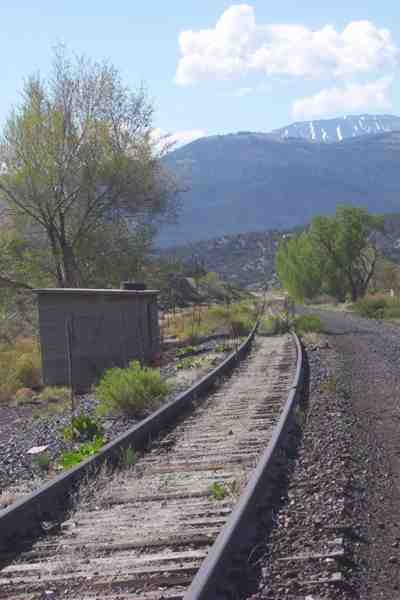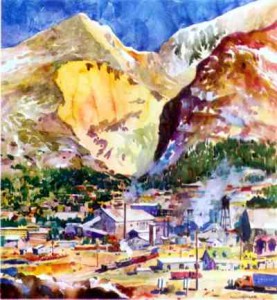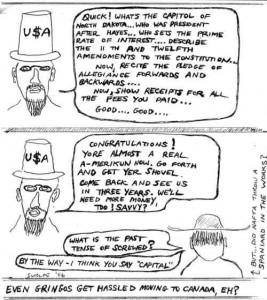Essay by Ed Quillen
Transportation – June 2006 – Colorado Central Magazine
SINCE I WAS a little kid, trains have fascinated me, and Salida’s status as a one-time rail hub was one factor that made the place attractive when we moved here in 1978. Passenger service had stopped in 1967. In 1971, Salida quit serving as a terminal where all freights changed crews. The immense old railroad shop building housed a limestone-processing plant, and the two roundhouses had been razed.
But the depot still stood at the north end of F Street, serving as the downtown focal point. Every summer morning, a train of 28 empty gondola cars rumbled across the river to Poncha Springs, Maysville and the Monarch Quarry, returning with full loads of limestone in the afternoon. An eastbound train on the main line would pick them up, and the limestone went to the steel mill in Pueblo.
In a certain sense, Salida was still on the job, doing what it was built to do in 1880. That has certainly changed. The tracks to the quarry were torn out in 1984 after CF&I closed its blast furnaces in Pueblo. The depot came down early the next year. The Denver & Rio Grande Western Railroad was merged into the Southern Pacific which was merged into the Union Pacific which put this one-time main line out of service a few years ago. The tracks are still there, but no trains run on them.
Meanwhile, this is still a pretty good place for a railroad buff. There are the old roadbeds over Marshall Pass and Poncha Pass, as well as the east and west approaches to the Alpine Tunnel, the Quarry Spur from Salida, the Midland near Buena Vista, and the Mineral Belt Trail east of Leadville. There are old depots, locomotives, and cabooses in various states of renovation.
And if you want to ride a tourist excursion train in the mountains, Salida is still pretty much in the middle of things, even if it doesn’t have trains itself. There’s the Royal Gorge Route to the east, the Leadville, Colorado & Southern to the north, and to the south, the Cumbres & Toltec as well as the new San Luis & Rio Grande excursions from Alamosa to La Veta and Antonito.

So Salida could promote itself as a central place for a mountain railroad buff to stay for a week’s vacation, with lots to explore and plenty of scenic passenger service within a 90-minute drive. And even without such promotion, they come — a couple of months ago I was talking with a bed-and-breakfast owner who told me she often got railroad questions from her guests.
Which inspired me to ponder writing and publishing a “Railroad Buff’s Guide to the Salida Area,” although I didn’t even get much pondering done before I had to turn my attention to other work. Meanwhile, I’ve heard people say they wish Salida had a tourist train, or that they wish rail service would resume here.
When I rode the Alamosa-La Veta media-junket excursion in February, there was much talk in the parlor car that the Union Pacific was going to re-open the Tennessee Pass line because its Moffat Tunnel Route was running at capacity. And it was just a rumor — the Moffat Route is at or near capacity, but there are no plans to re-open Tennessee Pass. It’s a steep, slow, and expensive route.
And even if it were re-opened, it would just mean noise and aggravation here. The trains would just rumble through. They wouldn’t stop to serve local shippers and they wouldn’t get big trucks off our highways.
If the railroad could resume the role it had a century ago, when it served local industry and took passengers to and from near and far destinations, it would be worth having. But as things work now, the trains would be no blessing.
AS FOR A TOURIST TRAIN in Salida, it would likely run only in the summer, when we already seem to have plenty of tourists. To get here to take it, many tourists would have to drive past other tourist trains in Leadville, Cañon City, and Alamosa. I don’t know how many trains the Colorado tourist industry could support — there’s got to be a saturation point at some level.
And there’s another factor. On April 30, Martha and I rode one of America’s better passenger trains, the Cascades, which is operated jointly by Amtrak and the states of Washington and Oregon. We had gone to the Pacific Northwest to visit some old college friends, Bill and Jan Hays in Seattle, as well as our daughters Abby, in Eugene, Ore., and Columbine, in Bend, Ore. We flew to Seattle on a Friday, and in Seattle we boarded Amtrak 507 to Eugene on a Sunday afternoon. We were riding a train, not just to ride a train, but to get from one place to another.
It’s a comfortable ride because it’s a “Talgo train,” designed and partly built in Spain. There are hydraulic arms under the coaches that keep them level on curves. The train makes decent time and the scenery is often interesting, and when it isn’t, there’s plenty of leg room and you can walk around and it’s a lot more comfortable than an airplane.
But things do not always proceed according to plan on the rails. Our train sat at the Olympia station for more than two hours, waiting for the line to clear. While passing through Centralia, the northbound passenger train hit and killed Kristina Sabin, a 33-year-old woman who was walking along the tracks while wearing headphones. She never heard the train come up behind her, even as its whistle screamed and the wheels shrieked from the emergency brakes.
All rail traffic along that busy route was halted until the death scene could be investigated and cleared; so we didn’t get into Eugene until nearly three hours after the timetable schedule.
Railroad officials were quick to point out that “It is against the law to trespass on the tracks,” and “This is one of the reasons why.”
WELL, I BREAK THAT LAW almost every day when I walk our dog, Bodie. He loves to chase cars, and few autos move along or near the railroad right-of-way. It’s a gentle grade which makes for easy walking for my complaining 55-year-old knees. There’s interesting stuff to look at — old narrow-gauge alignments, the ruins at the Barrel siding, wagon roads up to quarries in the Arkansas Hills, mule deer and bighorn sheep. There are a few other dog walkers and an occasional jogger, but often Bodie and I have it to ourselves.
I’m not too worried about being arrested for trespassing. By and large, the railroad right-of-way was granted by the federal government in 1880 on the grounds that it would benefit the public. And if the railroad company isn’t going to operate trains to benefit the public, there’s at least some public benefit in having a good place to walk. Or so I would want to argue if I were hailed into court.
In fact, though, that’s just sophistry, a rationalization.
The corridor is a fine recreational zone when the trains aren’t running, and I like it just as it is. But I know that the present situation is too good to last indefinitely. America could get serious about energy-efficient transportation, and rail traffic might resume here. Or more likely, the Union Pacific will actually abandon the route and pull up the rails, and the corridor will become part of the state park system, a 170-mile trail from Gypsum to Tennessee Pass to Parkdale that will have fees and regulations and a lot more people.
In the past 50 years, Salida has adjusted to not being a railroad town. In the past 10, I’ve adjusted to not having trains here. I’ve adjusted so well that I don’t want the trains back. I’ve also adjusted to having a place to wander around with my dog, one where I don’t have to worry about leashes and pooper-scoopers.
The old railroad corridor is a thoroughly used path — replete with grease, rusted metal, broken insulators, splintered ties, and blackened ballast — where I don’t have to feel guilty for disturbing pristine nature. As I said, the current situation is about perfect. There’s safe walking in and near town, and if I want to ride a train, there are fine scenic excursions within convenient driving distance.
Of course things will change someday, and more adjustments will be necessary. But the longer it can be put off, the better.



